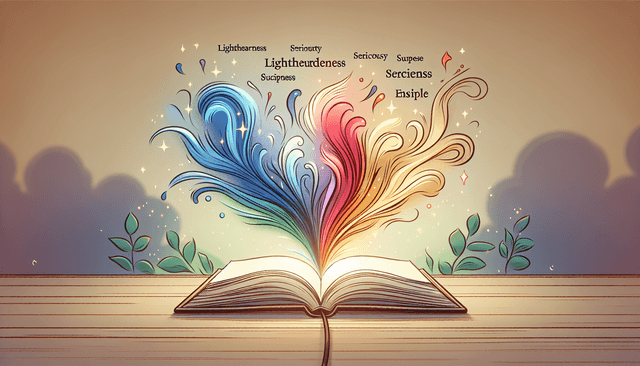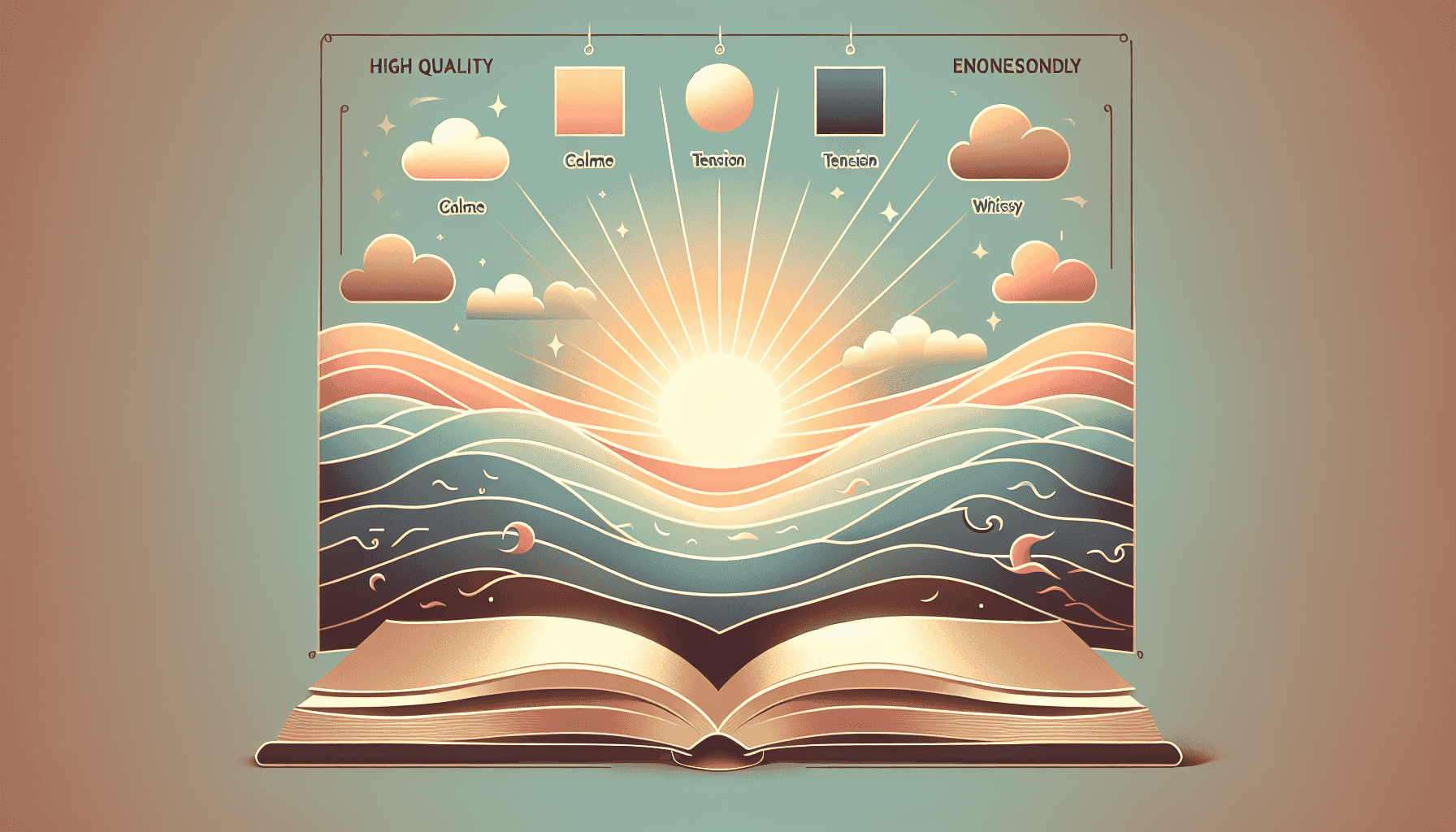Table of Contents
Understanding tone in literature can feel a bit tricky at first. You’re not alone if you’ve ever read a story and thought, “What’s the vibe here?” Tone sets the mood and reveals the author’s attitude, but it might seem elusive as you dig deeper into different texts.
Stick around, and I promise you’ll get the hang of it! By the end, you’ll not only know what tone is but also how to identify it, understand its importance, and even apply it in your own writing. It’s like unlocking a secret door to a richer reading experience.
We’ll start with the basics and gradually explore how tone can dramatically shape a story. From recognizing different types of tone to practicing with examples, you’ll be well on your way to mastering this essential literary element.
Key Takeaways
- Tone in literature reflects the author’s attitude and significantly shapes the reader’s emotional experience.
- Common tones include optimistic, pessimistic, serious, humorous, and sarcastic; identifying these can enhance reading comprehension.
- Understanding tone is crucial for character development and plot progression, as shifts can signal key moments in a story.
- To find tone, pay close attention to word choice, sentence structure, and context.
- Tone and mood are interconnected; tone influences the emotional atmosphere perceived by the reader.
- Authors intentionally choose tones to enhance storytelling and evoke specific feelings in their audience.
- Practice writing in different tones to develop your unique voice and improve overall writing skills.

1. Understand Tone in Literature
Tone in literature refers to the author’s attitude toward the subject or the audience. It can shape how readers perceive the entire piece, creating a specific atmosphere and emotional landscape. For instance, a work with a sarcastic tone might evoke laughter, while a somber tone could lead to reflection. To better understand tone, consider the word choice, sentence structure, and even the pace of the narrative. When analyzing tone, you can ask yourself questions like, “How does the author use language to convey emotion?” or “What feelings are provoked by the text?” Recognizing tone can enhance your reading experience and improve your writing skills.
2. Identify Different Types of Tone
Tones vary widely, and identifying them can be a fun exercise. Some common tones include optimistic, pessimistic, serious, humorous, and sarcastic. For example, an optimistic tone radiates positivity and hope, often seen in inspirational books or films. Meanwhile, a pessimistic tone can create a sense of despair or hopelessness, often found in tragedies. You can practice identifying tone by reading excerpts from various genres and determining the author’s attitude based on context and language. Think of tone as the emotional fingerprint left by the writer; it’s unique and tells you a lot about the underlying message.
3. Recognize the Importance of Tone
The importance of tone in literature can’t be overstated; it shapes reader engagement and influences interpretation. A well-crafted tone can draw readers in, making the story relatable or immersive. If you’ve ever read a piece that felt “flat,” it was likely due to an ineffective tone. Furthermore, tone plays a crucial role in character development and plot progression. Consider how a shift in tone can signal a turning point in a story. By paying attention to tone, you can deepen your understanding of themes and character motivations. It also encourages writers to explore their style — refining their unique voice to resonate with readers.

4. Analyze How Tone Affects a Story
Tone can significantly influence the reader’s experience and interpretation of a story. For instance, a lighthearted tone can transform a serious subject matter into something more approachable. Conversely, a grave tone can heighten the emotional stakes, making the reader feel more invested in the characters and plot.
Consider the opening tone of a mystery novel. If it’s filled with suspenseful language, readers are likely to remain on the edge of their seats, eager to see what happens next. Analyzing how tone shifts throughout the narrative can reveal character development and plot twists.
To practice this, pick a favorite book and underline examples of tone changes at critical junctures. Reflect on how these shifts influence your feelings about the characters and events. This analysis will deepen your understanding of the text and enhance your appreciation of the author’s craft.
5. Learn How to Find Tone in Texts
Determining tone isn’t as daunting as it sounds. Start by closely reading the text and paying attention to the author’s choice of words. Are they using formal language, or is it more conversational?
Next, analyze the sentence structure. Short, choppy sentences can create urgency, whereas longer, complex sentences might evoke thoughtfulness. Context also plays a key role; consider how the setting and character emotions contribute to the overall tone.
To practice, find a short story and write down words or phrases that stand out to you. Then, summarize the tone in just one sentence. This exercise sharpens your analytical skills and helps you spot tones in future readings.
6. Practice Identifying Tone Through Examples
Nothing beats hands-on practice when it comes to identifying tone. Grab a selection of texts — they could be poems, excerpts from novels, or even articles. As you read, pause to reflect on the tone presented.
For example, in a poem about nature, does the author evoke a sense of tranquility or despair? A political article might carry a tone of urgency or skepticism. Write down your observations.
Another great practice is to discuss your findings with a friend. Dialogue often helps clarify thoughts and solidifies understanding. Consider setting a timer for 15 minutes and dive into different texts to see how many tones you can identify in that time!
7. Explore the Relationship Between Tone and Mood
Tone and mood work hand in hand but represent different aspects of a literary piece. While tone reflects the author’s attitude, mood is the emotional atmosphere that the reader perceives. This means a light, humorous tone can create a cheerful mood, while a serious or somber tone might induce feelings of sadness or urgency.
To grasp this relationship, examine how changing the tone can affect the mood. For example, a comic scene can quickly shift to tension-filled horror through a sudden change in tone. Analyzing this shift will give you insight into how authors manipulate these elements.
Try picking a scene from a movie or book and rewriting it to change the tone. Observe how your rewrite shifts the mood and impacts the overall experience. This exercise enhances your awareness of these key elements in storytelling.
8. Discover How Authors Use Tone for Effect
Authors aren’t just picking tones on a whim; they carefully choose them to serve their storytelling goals. For instance, a novel that employs irony can lead to deeper themes and provoke critical thought in readers.
Consider how dramatic irony creates tension. When the audience knows something the characters don’t, it can create humor or suspense, depending on the tone used.
Another way authors utilize tone is through character dialogue. A sarcastic tone in a character’s speech can reveal layers of their personality and lead to interesting dynamics with others.
Try analyzing character dialogues in your favorite novels. Note the tones and see how they affect your perception of the characters. This deeper understanding will aid in your writing and character development.
9. Use Tone in Your Own Writing
Now that you understand tone’s significance, it’s time to apply it in your writing. Start by deciding what emotional response you’d like to evoke from your readers. This will guide your tone choices throughout your piece.
Consider drafting a short paragraph using two different tones — one playful and another serious — for a similar scene. Compare how each version alters the reader’s perception and emotional journey.
Additionally, you might find tools like the [IBM Watson Tone Analyzer](https://www.ibm.com/watson/tone-analyzer/) helpful. They can analyze the emotional tones in your writing, providing feedback that you can use to refine your approach.
Finally, practice writing in multiple genres. Switching genres helps stretch your abilities and allows you to explore various tones. Whether it’s a cozy mystery or a heartfelt memoir, each style encourages different tonal choices, keeping your writing fresh and engaging.
FAQs
Tone in literature refers to the author’s attitude toward the subject matter or audience. It can be conveyed through word choice, sentence structure, and stylistic elements, influencing how readers interpret the text.
Tone shapes the reader’s emotional response and understanding of events. A serious tone can heighten drama, while a humorous tone can lighten tension, both significantly impacting character perception and plot engagement.
Tone is the author’s attitude towards the subject, while mood is the emotional atmosphere experienced by the reader. Both elements interact, yet they influence the reading experience in distinct ways.
To identify tone, analyze word choice, punctuation, and sentence structure. Consider the overall context and emotion conveyed in the text. Look for descriptive language and specific examples that reveal the author’s attitude.



